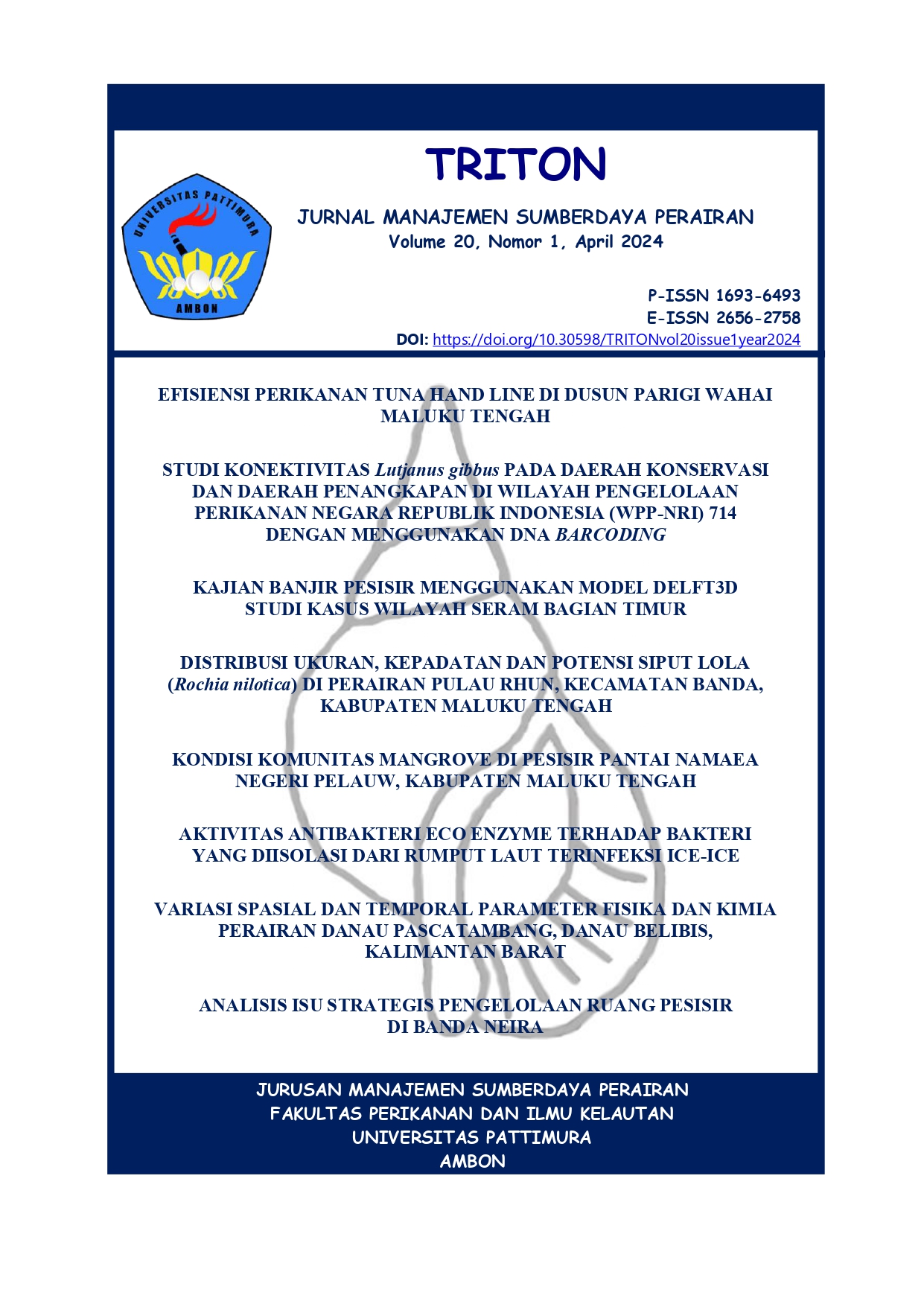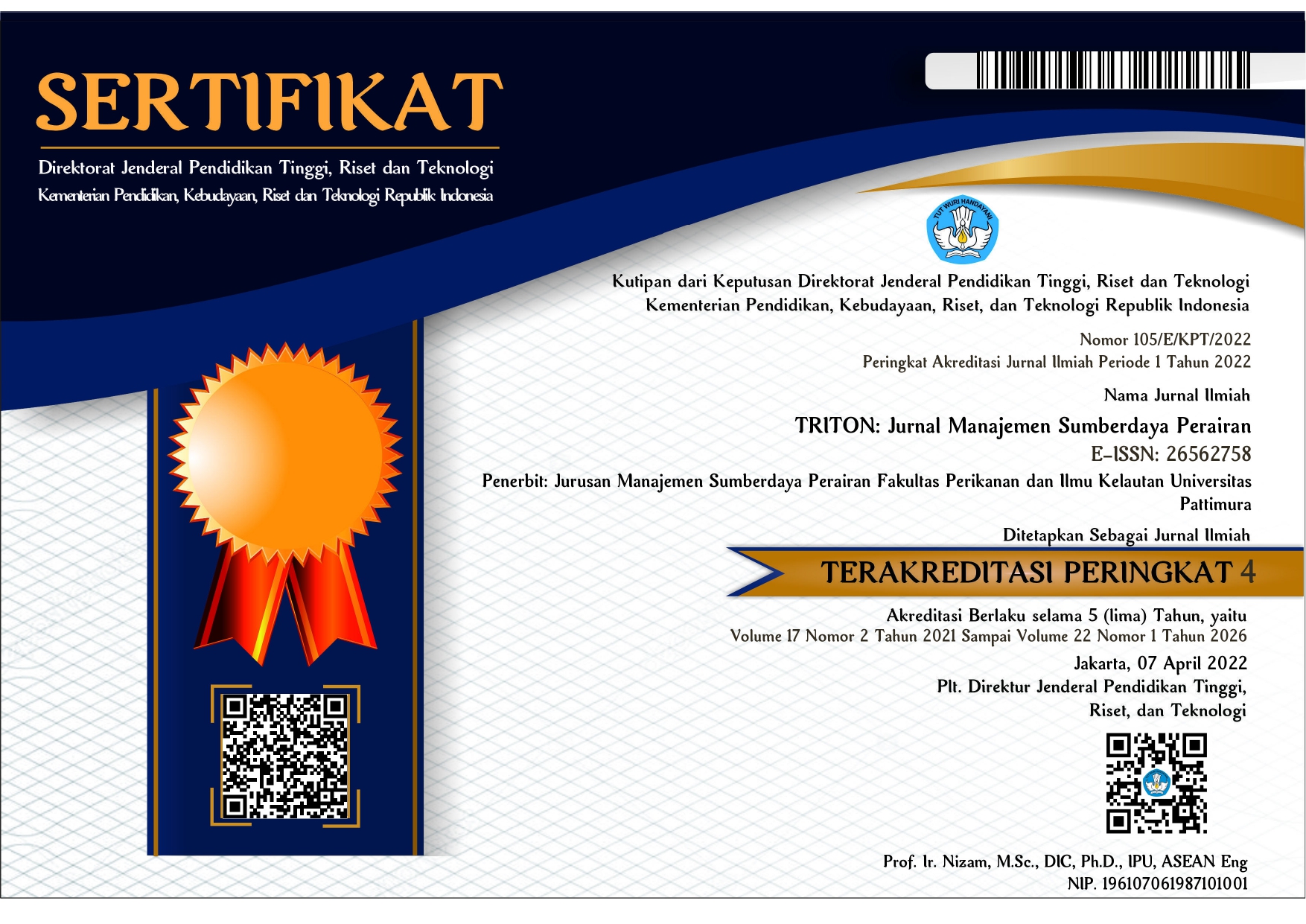AKTIVITAS ANTIBAKTERI ECO ENZYME TERHADAP BAKTERI YANG DIISOLASI DARI RUMPUT LAUT TERINFEKSI ICE-ICE
Abstract
Eco enzyme is the result of fruit peel fermentation mixed with brown sugar water. Eco enzyme contains acetic acid that can inhibit the growth of bacteria, including bacteria isolated from seaweed infected with ice-ice disease. The purpose of this study was to analyze the antibacterial activity of eco enzyme to inhibit bacteria isolated from seaweed infected with ice-ice. This research was conducted in July-November 2023. The inhibition test was conducted at the BPBL Ambon Testing Laboratory, while the phytochemical test was conducted at the Herbal Materia Medica Laboratory in Batu, Malang. Eco enzyme was made at the Aquatic Resource Management Laboratory, Faculty of Fisheries and Marine Science, Pattimura University for three months. The method for antibacterial test of eco enzyme used disc diffusion method. There are four types of bacteria that have been isolated from ice-ice infected seaweed, namely Vibrio alginolyticus, Vibrio fluvalis, Vibrio cholerae, and Aeromonas cavie. There are four concentrations of eco enzyme used to inhibit the growth of isolated bacteria, namely 25%, 50%, 75% and 100%. Phytochemical test results showed that the eco enzyme solution contained phenol of 319.0921 mg GA/g, total flavonoids of 133.5000 mg Q/g, total tannins of 224.6916 mg ET/g, and IC50 value on DPPH (1,1-diphenyl-2-picrylhydrazil) method of 290.9558 ppm. Based on the results of the inhibition test, the greater the concentration of eco enzyme, the greater the inhibition zone produced. Inhibition zone with moderate category was found in bacteria V. alginolticus and A. cavie with 100% concentration, while others were included in the weak category.
ABSTRAK
Eco enzyme merupakan hasil fermentasi kulit buah dicampur dengan gula merah air. Eco enzyme mengandung asam asetat yang dapat menghambat pertumbuhan bakteri, antara lain bakteri yang diisolasi dari rumput laut yang terinfeksi penyakit ice-ice. Tujuan dari penelitian ini yaitu menganalisis aktivitas antibakteri eco enzyme untuk menghambat bakteri yang diisolasi dari rumput laut terinfeksi ice-ice. Penelitian ini dilakukan pada Juli-November 2023. Uji hambat dilakukan di Laboratorium Penguji BPBL Ambon, sedangkan untuk uji fitokimia dilakukan di Laboratorium Herbal Materia Medica Batu, Malang. Eco enzyme dibuat di Laboratorium MSP FPIK UNPATTI selama tiga bulan. Metode untuk uji antibakteri eco enzyme menggunakan metode difusi cakram. Terdapat empat jenis bakteri yang telah diisolasi dari rumput laut terinfeksi ice-ice yaitu Vibrio alginolyticus, Vibrio fluvalis, Vibrio cholerae, dan Aeromonas cavie. Terdapat empat konsentrasi eco enzyme yang digunakan untuk menghambat pertumbuhan bakteri isolasi yaitu 25%, 50%, 75% dan 100%. Hasil uji fitokimia menunjukan bahwa larutan eco enzyme mengandung Fenol sebesar 319,0921 mg GA/g, total Flavonoid sebesar 133,5000 mg Q/g, total Tanin sebesar 224,6916 mg ET/g, dan nilai IC50 pada metode DPPH (1,1-diphenil-2-picrylhydrazil) sebesar 290,9558 ppm. Berdasarkan hasil uji hambat diperoleh semakin besar konsentrasi eco enzyme maka semakin besar pula zona hambat yang dihasilkan. Zona hambat dengan kategori sedang ditemukan pada bakteri V. alginolticus dan A. cavie dengan konsentrasi 100%, sedangkan lainnya termasuk dalam kategori lemah.
Kata Kunci: Eco enzyme, antibakteri, fitokimia, rumput laut, ice-ice
Downloads
References
Andani, L., Sari, N. M., Salusu, H. D., Yusdiansyah, Wartomo, Prayitno, J., & Aryani, F. (2022). Analisis Fitokimia, Aktivitas Antioksidan Dan Antibakteri Daun Andong (Cordyline fruticosa). Perennial, 18(2), 39–44. https://doi.org/http://dx.doi.org/10.24259/perennial.v18i2.22466
Asih, I. A. R. A., Rita, W. S., Ananta, I. G. B. T., & Wahyuni, N. K. D. M. S. (2018). Aktivitas Antibakteri Ekstrak Kulit Pisang (Musa sp.) Terhadap Escherichia coli Dan Staphylococcus Aureus Serta Identifikasi Golongan Senyawa Aktifnya. Cakra Kimia (Indonesian E-Journal of Applied Chemistry, 6(1), 56–63.
Ayu, P., Kasih, N., Pandit, I. G. S., Cahyawati, P. N., Sri, A., & Aryastuti, A. (2023). Antimicrobial Properties of Eco Enzyme : A Literature Review. Bioscientia Medicina : Journal of Biomedicine & Translational Research, 7(6), 3370–3376. https://doi.org/https://doi.org/10.37275/bsm.v7i6.831
Benny, N., Shams, R., Dash, K. K., Pandey, V. K., & Bashir, O. (2023). Recent trends in utilization of citrus fruits in production of eco-enzyme. Journal of Agriculture and Food Research, 13(January), 1–10. https://doi.org/10.1016/j.jafr.2023.100657
BPS. (2022). Provinsi Maluku Dalam Angka 2022.
Cao, J., Zhang, J., Ma, L., Li, L., Zhang, W., & Li, J. (2018). Identification of fish source Vibrio alginolyticus and evaluation of its bacterial ghosts vaccine immune effects. MicrobiologyOpen, 7(3), 1–11. https://doi.org/10.1002/mbo3.576
Davis, W. W., & Stout, T. R. (1971). Disc plate method of microbiological antibiotic assay. I. Factors influencing variability and error. Applied Microbiology, 22(4), 659–665. https://doi.org/10.1128/aem.22.4.659-665.1971
Duma, I., Irianto, K., Purnomo, K., Amanati, A., Savila, D., & Mardiyaningsih, A. (2023). Antibacterial activity of eco-enzyme waste of Citrus sinensis, Musa paradisiaca L. var bluggoe, and their combination against Staphylococcus aureus. Majalah Farmasetik, 19(4), 504–513.
Erbabley, N. Y. G. F., & Kelabora, D. M. (2018). Identifikasi Bakteri Rumput Laut Kappaphycus alvarezii Berdasarkan Musim Tanam di Perairan Maluku Tenggara. Akuatika Indonesia, 3(1), 19. https://doi.org/10.24198/jaki.v3i1.23398
Erniati, Erlangga, S., Imanullah, & Andika, Y. (2024). Aktivitas Antioksidan Dan Total Fenol Rumput Laut Sargassum sp. Dari Perairan Simeulue Aceh. JPHPI, 27(3), 186–196. https://doi.org/http://dx.doi.org/10.17844/jphpi.v27i3.46981
Fadli, M., Aryawati, R., & Agustriani, F. (2021). Kajian fungsi perendaman rumput laut jenis Kappaphycus alvarezii pada air tawar untuk meminimalisir serangan penyakit ice-ice. Maspari Journal, 13(2), 83–88.
Fajrina, R. F. N., Rahayu, I. G., Wahyuni, Y., & Rahmat, M. (2019). Aktivitas Antibakteri Ekstrak Kulit Pisang Ambon (Musa Acuminata Colla) Terhadap Staphylococcus Aureus Secara in-Vitro. Jurnal Riset Kesehatan Poltekkes Depkes Bandung, 11(1), 230–235. https://doi.org/10.34011/juriskesbdg.v11i1.744
Gayanti, A. N. S., Suartha, I. N., & Sudipa, P. H. (2023). Uji Aktivitas Antibakteri Ekoenzim Terhadap Bakteri Escherichia coli yang Diisolasi Dari Kulit Anjing. Buletin Veteriner Udayana, 15(4), 667–673. https://doi.org/10.24843/bulvet.2023.v15.i04.p19
Hikal, W. M., Said-Al Ahl, H. A. H., Bratovcic, A., Tkachenko, K. G., Sharifi-Rad, J., Kačániová, M., Elhourri, M., & Atanassova, M. (2022). Banana Peels: A Waste Treasure for Human Being. Evidence-Based Complementary and Alternative Medicine, 2022. https://doi.org/10.1155/2022/7616452
Imelda, D., Lubena, L., Satriawan, B. D., & Brilianti, A. (2022). Formulasi Bahan Aktif Antimikroba Alami Dari Larutan Eco-Enzyme Limbah Kulit Buah Dalam Pembuatan Multipurpose Sanitizer. Prosiding Seminar Nasional Universitas PGRI Palangka Raya, 1, 106–113. https://doi.org/10.54683/puppr.v1i0.14
Løvdal, T., Lunestad, B. T., Myrmel, M., Rosnes, J. T., & Skipnes, D. (2021). Microbiological food safety of seaweeds. Foods, 10(11), 1–22. https://doi.org/10.3390/foods10112719
Maida, S., & Lestari, A. P. (2019). Aktivitas Antibakteri Amoksisilin Terhadap Gram Positif dan Bakteri Gram Negatif. J. Pijar MIPA, 14(3), 189–191. https://doi.org/10.29303/jpm.1029
Maryunus, R. P. (2018). Pengendalian penyakit ice-ice budidaya rumput laut, Kappaphycus alvarezii: Korelasi musim dan manipulasi terbatas lingkungan. Jurnal Kebijakan Perikanan Indonesia, 10(1), 1–10. https://doi.org/DOI: http://dx.doi.org/10.15578/jkpi.10.1.2018.1-10
Masykuroh, A., & Puspasar, H. (2022). Aktivitas Anti Bakteri Nano Partikel Perak (NPP) Hasil Biosintesis Menggunakan Ekstrak Keladi Sarawak Alocasia macrorrhizos Terhadap Staphylococcus aureus dan Escherichia coli. BIOMA : Jurnal Biologi Makasar, 7(1), 76–85. https://doi.org/10.16995/glossa.issue.829
Mavani, H. A. K., Tew, I. M., Wong, L., Yew, H. Z., Mahyuddin, A., Ghazali, R. A., & Pow, E. H. N. (2020). Antimicrobial efficacy of fruit peels eco-enzyme against Enterococcus faecalis: An in vitro study. International Journal of Environmental Research and Public Health, 17(14), 1–12. https://doi.org/10.3390/ijerph17145107
Muhy Aldean, A. A., Al-Jumaily, E. F., & Al-Safar, M. A. (2010). The Effect of Banana Skin on the Bacterial Infections of the Chronic Gingivitis Patients. Al Mustansiriyah Journal of Pharmaceutical Sciences, 7(1), 145–149. https://doi.org/10.32947/ajps.v7i1.327
Muliarta, I. N., & Darmawan, I. K. (2021). Processing Household Organic Waste into Eco-Enzyme as an Effort to Realize Zero Waste. Agriwar Journal, 1(1), 6–11.
Nashrullah, M. F., Susanto, A. B., Pratikto, I., & Yati, E. (2021). Analisis Kesesuaian Lahan Budidaya Rumput Laut Kappaphhycus alvarezii (Doty) menggunakan Citra Satelit Di Perairan Pulau Nusa Lembongan, Bali. Journal of Marine Research, 10(3), 345–354. https://doi.org/10.14710/jmr.v10i3.30507
Permatananda, P. A. N. K., & Pandit, I. G. S. (2023). Characteristic of Orange Peel Waste-Based on Eco Enzyme at Different Fermentation Duration. Jurnal Penelitian Pendidikan IPA, 9(6), 4289–4293. https://doi.org/10.29303/jppipa.v9i6.3527
Puger, I. G. N. (2018). Sampah Organik, Kompos, Pemanasan Global, Dan Penanaman Aglaonema Di Pekarangan. Agro Bali: Agricultural Journal, 1(2), 127–136. https://doi.org/10.37637/ab.v1i2.314
Rahayu, M., Muliarta, I. N., & Situmeang, Y. P. (2021). Acceleration of Production Natural Disinfectants from the Combination of Eco-Enzyme Domestic Organic Waste and Frangipani Flowers (Plumeria alba). SEAS (Sustainable Environment Agricultural Science), 5(1), 15–21. https://doi.org/10.22225/seas.5.1.3165.15-21
Siddik, M. A. B., Francis, P., Rohani, M. F., Azam, M. S., Mock, T. S., & Francis, D. S. (2023). Seaweed and Seaweed-Based Functional Metabolites as Potential Modulators of Growth, Immune and Antioxidant Responses, and Gut Microbiota in Fish. Antioxidants, 12(12). https://doi.org/10.3390/antiox12122066
Singh, C., Kathiresan, Boopathy, N., Anandhan, S., & Govindan, T. (2013). Evaluation of Microbial Potential of Different Colored Banana Peels. International Journal of Preclinical and Pharmaceutical Research, 4(2), 62–64.
Sugumaran, R., Padam, B. S., Yong, W. T. L., Saallah, S., Ahmed, K., & Yusof, N. A. (2022). A Retrospective Review of Global Commercial Seaweed Production—Current Challenges, Biosecurity and Mitigation Measures and Prospects. International Journal of Environmental Research and Public Health, 19(12). https://doi.org/10.3390/ijerph19127087
Sundu, R., Supriningrum, R., & Fatimah, N. (2022). Kandungan Total Senyawa Fenol, Total Senyawa Flavonoid dan Aktivitas Antioksidan Ekstrak Etanol Kulit Batang Sekilang (Embelia borneensis Scheff.). Bivalen: Chemical Studies Journal, 5(2), 31–36. http://jurnal.fkip.unmul.ac.id/index.php/bivalen
Syamsuddin, R., & Rahman, S. A. (2014). Penanggulangan penyakit ice-ice pada rumput laut Kappaphycus alvarezii melalui penggunaan pupuk N , P , dan K. Simposium Nasional I Kelautan Dan Perikanan, 1–9.
Tuhumury, N. C., Sahetapy, J. M. F., & Matakupan, J. (2024). Isolation and identification of bacterial pathogens causing ice-ice disease in Eucheuma cottonii seaweed at Seira Island Waters, Tanimbar Islands District, Maluku, Indonesia. Biodiversitas, 25(3), 964–970. https://doi.org/10.13057/biodiv/d250308
Tuhumury, N. C., Sangadji, D. M. D., & Ummah, A. N. A. (2023). Analisis Timbulan Sampah dan Pemanfaatan Sampah Organik Berbasis Eco enzyme Pada Kawasan Wisata Kuliner Air Salobar, Kota Ambon. Jurnal Pengendalian Pencemaran Lingkungan (JPPL), 5(2), 142–149. https://doi.org/10.35970/jppl.v5i2.2021
Yanamisra, A., Fariyanti, A., & Dwi Utami, A. (2023). Risiko Produksi Dan Harga Pada Usahatani Rumput Laut Di Kabupaten Takalar Provinsi Sulawesi Selatan. Forum Agribisnis, 13(2), 137–151. https://doi.org/10.29244/fagb.13.2.137-151
Copyright (c) 2024 Novianty C Tuhumury, Jacqueline M F Sahetapy, Jolen Matakupan, Stefanno M A Rijoly

This work is licensed under a Creative Commons Attribution-NonCommercial-ShareAlike 4.0 International License.


1.png)










